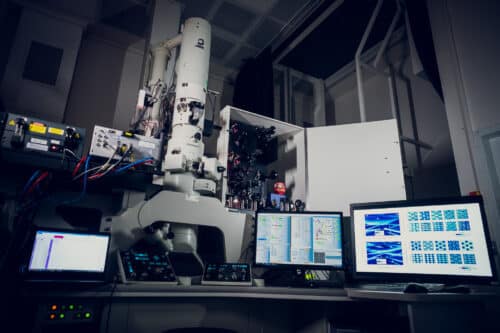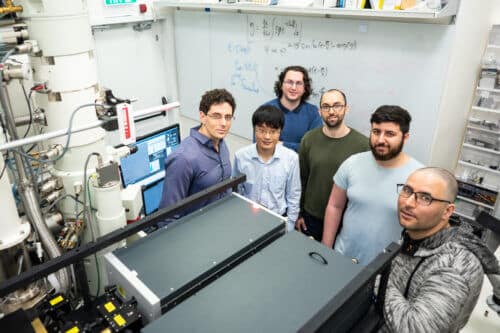A dramatic scientific achievement published in the journal Nature: researchers at the Technion assembled a quantum microscope that photographs the flow of light for the first time in the world, and used it to make a direct experimental observation of the light trapped in a photonic crystal

An article published in the journal Nature presents an innovative microscopy system that generates an unprecedentedly powerful interaction between light and matter. The system, built at the Technion through the integration and refinement of products from the world of microscopy and laser, is the best in the world in the combination of resolution in time, space and frequency.
The research was led by Dr. Ado Kaminer, head of the Robert and Ruth Magid Laboratory for Quantum Dynamics of Electron Beams and a faculty member at the Viterbi Faculty of Electrical Engineering and the Solid State Institute. Dr. Kaminer is also a member of the Russell Berry Nanotechnology Institute (RBNI) and the Helen Diller Quantum Center.
Co-authors in the article are Dr. Knafgang Wang, Raphael Dahan, Michael Shentzis, Dr. Yaron Kaufman, Uri Reinhardt, Adi Ben-Hayon, and Shai Tsass.
The aforementioned system, which was built with significant support from the Technion and some of its leading researchers, enables an unprecedented mapping of the behavior of light trapped in nanometer structures such as a photonic crystal - a nanometer structure whose properties dictate the behavior of light within it.
Scientific and technological developments have led to a dramatic improvement in the quality and properties of photonic crystals, and they even allow the light to be trapped inside them for a while. According to Dr. Kaminer, "This is not the first time that photonic crystals or other nanophotonic structures capture light, but this is the first direct experimental observation of the light captured in them. In the new system we were able to demonstrate for the first time such an observation with new quantum means. This is the main achievement in the current research, and the reason for its publication in Nature."
The interaction between matter and light, and in particular between an electron and a photon, is a fascinating phenomenon that occupies many research groups in the world, especially when the light is trapped in resonant structures. These are structures that are able to capture the light for an extended period of time. This can be likened to two mirrors placed opposite each other and the light is reflected between them again and again, however in nanometer resonant structures the behavior of light is very different, and the interactions in these structures are essential in the development of innovative applications including quantum computers.
Electrons, in their common state, are not free. They are connected to atoms, molecules and entities called "quantum dots", and this connection limits them in many aspects. In recent years, many simulations have been presented that show encounters between light and free electrons that do not experience the same limitations, but they were not realized at the experimental level due to complex technological difficulties. Now, using the system built at the Technion, a direct experimental observation of the interaction between a free electron and a trapped photon has been conducted for the first time. In this way, a direct measurement of the lifetime of the trapped photons was also possible.
The researchers were able to observe the light while it was trapped in the crystal and map the interaction between it and an electron launched towards it. The aforementioned electron is used as a tool for photographing and mapping light with excellent resolution, thanks to its quantum interaction at the level of the single photon.

The system that Dr. Kaminer built at the Technion is based on an electron microscope - a device that launches a focused electron beam at the model being tested and examines the scattering of the electrons. To a certain extent, the electron microscope is similar to an optical microscope, only that here a beam of electrons is not sent to the model, and the focus of the beam is not based on optical lenses but on electromagnetic lenses (coils). The main advantage of the electron microscope over optical microscopes is its high resolution. Compared to an optical microscope, which is limited to a separation of about 200 nanometers, the electron microscope is able to achieve a separation below an angstrom (a tenth of a nanometer). The reason for the difference is the fact that the wavelength of the electron is much shorter than the wavelength of light.
"The standard electron microscope already provides us with unprecedented resolution," explains Dr. Kaminer, "but it also has some critical limitations: it only produces static images, without a continuous time sequence and without color." The new system built at the Technion combines in the electron microscope fast and powerful laser flashes that provide the two missing elements - dynamism and color. As mentioned, this system also allows direct measurement of the lifetime of the trapped photons.
Dr. Kaminer began to design the innovative system even before his return to the Technion, largely inspired by two important researchers who dealt with light-matter interactions: Prof. Fabrizio Carbone from EPFL (Lausanne Institute of Technology), in whose laboratory Dr. Kaminer stayed at the end of his post-doctorate His at MIT. At EPFL, Prof. Carbone conducted several pioneering demonstrations of the combination between electron microscopy and laser flashes, and together with Dr. Kaminer demonstrated there for the first time the coloring of microscope images using the coupling of an external laser source.
The second researcher was the late Prof. Ahmed Zeweil - the first Egyptian scientist to win the Nobel Prize in Science (Chemistry, 1999). In the last years of his life, Zvil developed an innovative method that combines electron microscopy and laser radiation; He showed that by means of short and fast laser flashes it is possible to characterize the composition of the material and the changes that occur in it during a chemical or optical interaction, and this with unprecedented resolutions.

Now, in his new lab at the Technion, Dr. Kaminer has taken this innovative experimental system into the world of quantum physics. He emphasizes the enormous contribution of laboratory engineer Raphael Dahan, who led the establishment of the innovative microscopy system at the Center for Electron Microscopy in the Faculty of Materials Science and Engineering at the Technion.
Beyond the enormous scientific achievement, which is important in itself, the article paves the way for new applications in quantum sensing devices, quantum information handling, strong coupling of light and matter, and electro-opto-mechanical actions in trapped light. In the assessment of the doctoral student Shay Tsass, who is a co-author of the article, "there is a potential here to create new combinations of electronic, optical and mechanical properties, and that is why we are talking about a new 'electro-opto-mechanics'."
According to Dr. Kaminer, "there is a potential here for a leap forward in our ability to apply electron microscopy to soft and other sensitive materials. The next challenge is to increase the efficiency of the interaction to levels that will allow the creation of new and unique quantum states."
Dr. Ado Kaminer completed a bachelor's degree in electrical engineering and physics at the Technion as part of the Psagot reserve program and the Rothschild Technion program for excellent students. He then completed a master's degree and a doctorate under the guidance of Research Prof. Moti Segev from the Faculty of Physics. Upon his release, he started a post-doctorate at MIT, under the guidance of Prof. Marin Sulejcic and Prof. John Joanopoulos, with the support of the Marie Curie Scholarship, the Rothschild Scholarship, and the MIT-Technion Scholarship. In 2018, he joined the Faculty of Electrical Engineering at Viterbi.
Over the years, Dr. Kaminer has won many awards and grants, including the Israel Physics Society prize for graduate students, the Outstanding Doctoral Thesis Award from the American Physical Society, an Azrieli Fellow and an ERC grant from the European Research Council.
Dr. Kangfeng Wang, who led the research as a postdoctoral student at the Technion, is the recipient of a Lady Davis Foundation scholarship. The research was also supported by the Israel National Academy of Sciences, which also awarded the Adams Scholarship to Shai Tsass, and by a scholarship from the Azrieli Foundation for faculty members to Dr. Ado Kaminer. The generous contribution of Bob and Ruth Magid made possible the establishment of the laboratory and all the experiments conducted as part of the research discussed here.
More of the topic in Hayadan:

9 תגובות
An instructive and educated article.
Sorry to the commenters, I thought I was the only one who saw it, now that I'm reading the comments, I'm glad to see that there are other readers who noticed the shape obtained from the pattern of trapped photons that may reflect the shape of the elementary light pattern - Star of David - a symbol that was designed thousands of years ago! I think it's amazing!
Sorry to the commenters, I thought I was the only one who saw, now that I also read the comments I am glad to see that other people have discovered the shape of the trapped photons pattern, which may reflect the shape of the elementary light pattern - Star of David - that was designed thousands of years ago, it's amazing!
In general, an array of circles at equal distances, when you activate some manipulation, you will get your Star of David
The proof that God is Jewish
Is it possible to get an explanation of how you get a photonic crystal and what is the size of a photon?
Is it just me or are you seeing the Star of David?
The structure of the Star of David is surprising in a basic configuration of nature.
Is it just me, or are you seeing the Star of David?
It's interesting that in the photo, around the circle there is a Star of David shape...